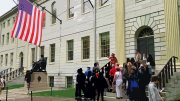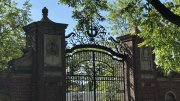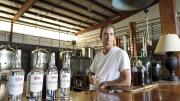Fall of junior year, I often woke up to a yell outside my window. Twice an hour, starting at about 11 a.m., I heard a group of people of varying ages letting out a long, measured scream, starting low and increasing in pitch, the way one shouts during “the wave.” After the first few times, I poked my head under the blinds to see what was going on, only to find a tour group standing in the street below. With Lowell House under construction, I was living above The Harvard Shop on Mount Auburn Street, which serves as the last stop for tours. If I looked out my window in the early afternoon, I often saw at least three groups ambling from stop to stop, like plastic pieces moving through a board game.
At midmorning on days above 60 degrees, tourists swarm Harvard Square. Clumps circulate through the Yard’s big attractions: Widener, Mass Hall, and, of course, the John Harvard statue. Visitors are like a fog that students wade through—for the most part unperceived, save for some days when the Yard is so flooded it’s difficult to navigate. Undergraduates acclimate to living in a tourist attraction; I’ve refined the art of giving directions to people who don’t know the name of the place they’re seeking, and have accidentally walked through enough people’s photos to fill a scrapbook. But even so, I couldn’t explain those screams. Though I overheard snippets of tours while walking to and from my dorm room, nothing seemed to relate. It was as if tourists and students walked through the University on parallel tracks, never making contact, inhabiting their own, separate Harvard experiences. I decided to investigate—perhaps there was some Harvard that tourists could see, but I couldn’t.
There is no single Harvard Tour; instead, there is an entire ecosystem of tour-giving, from official admissions tours for prospective students to a range of sightseeing tours. There are University-endorsed tours led by members of the undergraduate Crimson Key Society, but also privately owned tours that feed off Harvard parasitically: a tour led by a guy in Revolutionary War period costume; a tour with a 70-year-old man whom I’ve only heard referred to as “that guy.”
As I checked in at the front desk at the Harvard Information Center for the Crimson Key tour, I was handed a sticker proudly stating “Official Harvard Tour,” as if Harvard were sorting even its tourists into those institutionally approved and those not. This cachet seemed to be the Key’s main draw. I asked my student guide why he chose to give University tours rather than work for a private company, and he repeated that this was the official tour, blankly, as though the answer were obvious.
At no point in our official travels did anyone scream, which I suppose I should have expected. Crimson Key focuses, above all, on accuracy. The training handbook for the guides clarifies confusing details and corrects popular myths. For instance, one rule states, “The Polaroid Story is FALSE” (referring to the belief that the Science Center was designed to look like a Polaroid camera). “We have been explicitly asked not to tell this story. DO NOT MENTION IT.”
Even so, I was surprised that the Key tour had no overarching narrative. I expected the official tour narrative to depict a sanitized, clichéd version of Harvard filled with Kennedys and “the greatest students in the world.” Or, at a minimum, I expected the tour to proceed in chronological order. Instead it seemed a jumbled mix of facts, guided only by whichever landmark was closest—and tied together only by the guide’s personality. At each stop he followed up his historical anecdotes with a personal reflection, as if he was so moved by the memories provoked by each site that he had to share them. But it turns out that this structure was carefully designed—the Crimson Key handbook instructs guides to share their “positive” (it’s underlined for emphasis) experiences consistently with their group.
As we stood in Tercentenary Theatre, our guide recounted an anecdote about the Memorial Church bells waking him up freshman year, while I looked around and recognized the place I sat during Freshman Convocation. I remembered shifting in my seat under the sweltering August sun as College dean Rakesh Khurana explained to us that, having got into Harvard, we no longer had to jump through hoops; instead we should focus on pursuing “transformative experiences.” Our guide was a transformative-experience machine: no matter how idiosyncratic the anecdote—the 1764 library fire, undergrads kissing their dates under Johnston Gate for good luck—the guide had an aw-shucks personal tidbit to accompany it.
I suppose any undergraduate could filter Harvard life through the Crimson Key lens, compressing college into postcard-perfect platitudes. But as I watched the tour guide wrench personal significance from every single University site, I was reminded of the conversations I’ve had with my graduating friends, who’ve wondered if they have transformed the right way, if at all. They have, in fact, begun viewing Khurana’s encouragement to “transform” as another hoop to jump through. But without a grade or an acceptance letter at the end, they have struggled to find ways to make their personal growth concrete. They commodify their “transformation” for fellowship proposals and job applications and catalog their regrets and accomplishments at the end of each semester. They are solidifying the definitive narrative of their college experiences, as if creating tours of their own.
The Hahvahd Tour, owned by a private company, may not be official, but billboards in the Square advertise it as “the best.” It’s one of the most visible tours on campus, not only because its headquarters is right next to the T stop in the middle of the Square, but also because of its strictly enforced dorkiness. Guides must wear a straw hat emblazoned with the Hahvahd logo and recite a script filled with obligatory puns, making its undergraduate guides the subject of gentle ridicule.
I easily found my guide, wearing the signature hat. Most of the group had assembled, and we all introduced ourselves. Most were Canadian, with a few from small towns in the Northeast. When we got around the circle, I revealed that I also went to the College. “And here we have a Harvard student, looking to learn more about the university she attends,” said my guide, as if I were another on-campus attraction.
Qualifying as a Hahvahd Tour guide did not seem to demand the rigorous training of Crimson Key. The guide felt free to give speculative accounts (he told the Polaroid Story, for example). Where the Key capitalizes on students’ heartfelt anecdotes throughout, the only time the Hahvahd guides mention their experience is at the end. At our last stop, we gathered in front of the Lampoon building in a tight circle. “I’m going to let you in on some insider information about Harvard culture,” our guide said. He explained the pre-final-exam tradition of “Primal Scream,” in which some undergraduates run a lap through the Yard naked, purportedly to relieve stress before finals. (“Just another day in the life of the nation’s most talented students,” a man in the group quipped.) But when pressed, the guide revealed that he had never actually done Primal Scream.
“I don’t really feel comfortable with it,” he explained.
“I understand—shrinkage,” a man said, so encouragingly that it was unclear whether or not he was joking.
I had never participated either—I’ve never had a particularly strong desire to run around the Yard naked in front of a random swathe of my peers. Even so, we mimicked a “primal scream” in hesitating warbles in the middle of Mount Auburn Street. This was the noise I’d heard from my dorm-room window—an imitation of a Harvard ritual that no one in the group had ever done.
I found it strange that Hahvahd chose Primal Scream as the sole piece of “insider student information.” Even at that event, one always sees a group of curious tourists, watching the bacchanalia unfold and taking photos. Maybe there is no insider information. These student-led tours operate under the conceit that having a Harvard student show you around will give you a window into “the real Harvard,” whatever that may mean. But the tours I took didn’t reveal anything meaningful about the University that visitors couldn’t have guessed—even our Crimson Key guide’s heartfelt anecdotes about waking up to church bells and marveling at Gen Ed classes could have come from anyone.
But ultimately, the students are visitors, too, and as such there is a sense in which they never stop touring the University. Harvard funnels undergrads through a series of rituals as if they were stops on a tour—Convocation, getting into a House, picking a concentration, graduation. Even Khurana’s language of “transformative experiences” echoes the rhetoric of tourism—tourists and students alike walk through campus, hoping to be changed, at least slightly.
When we got back to the Yard, one of the tourists snapped a candid photo of her husband with our guide. The guide grimaced, both confused and slightly violated, but she pointed to her husband, still smiling from the photo, and shouted, “This is his dream!” The tour guide nodded, with a wry smile. It seemed unclear to him whether this man’s dream was to visit, or attend, the University or simply to be photographed with a tour guide. He took a moment to think, before finally saying, “Well, whatever your dream is, I hope you found it at here at Harvard.”









